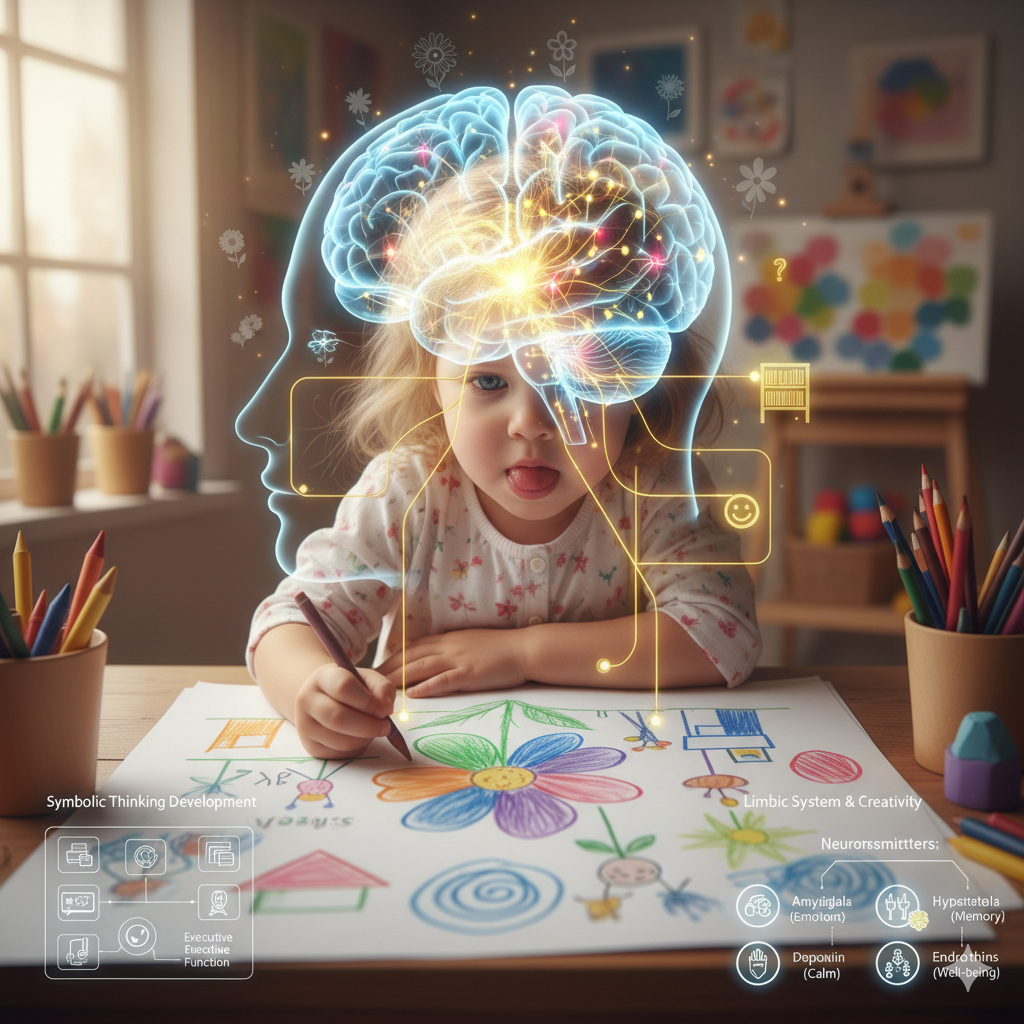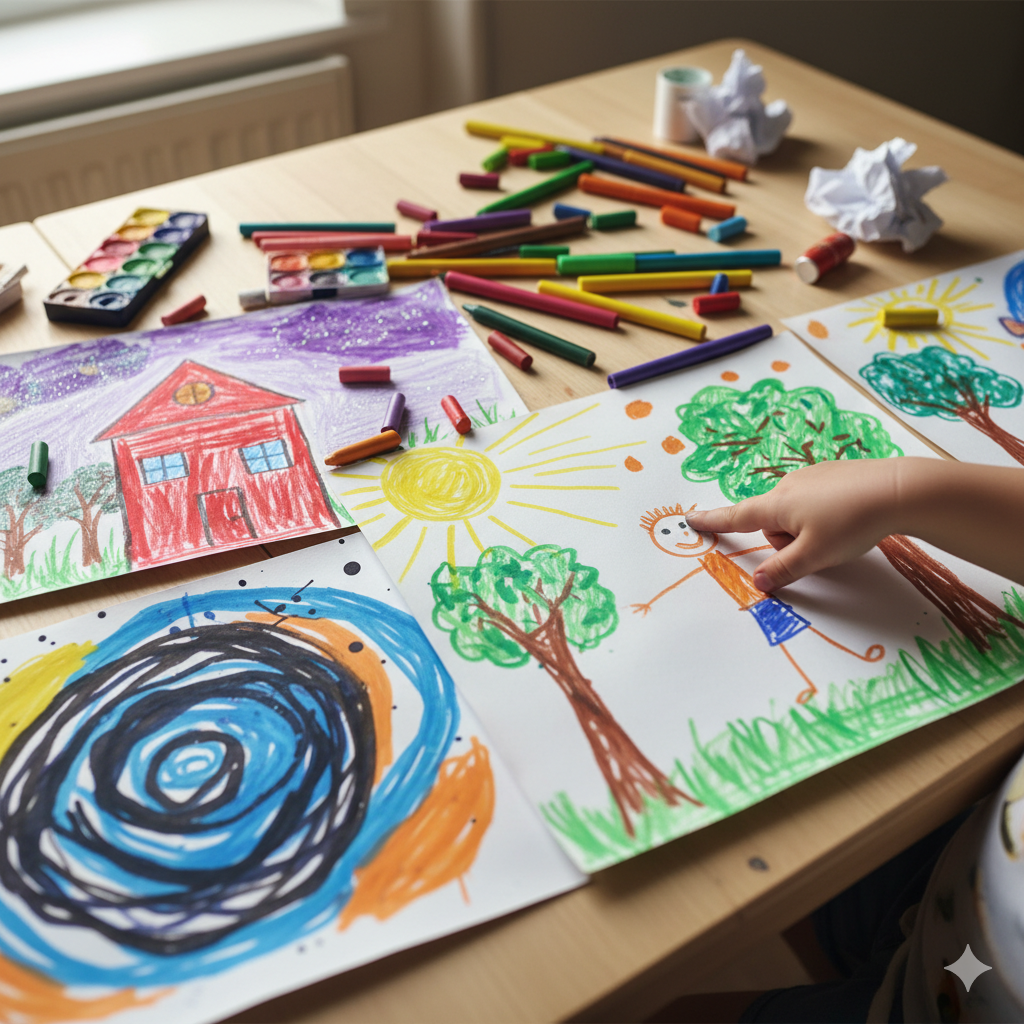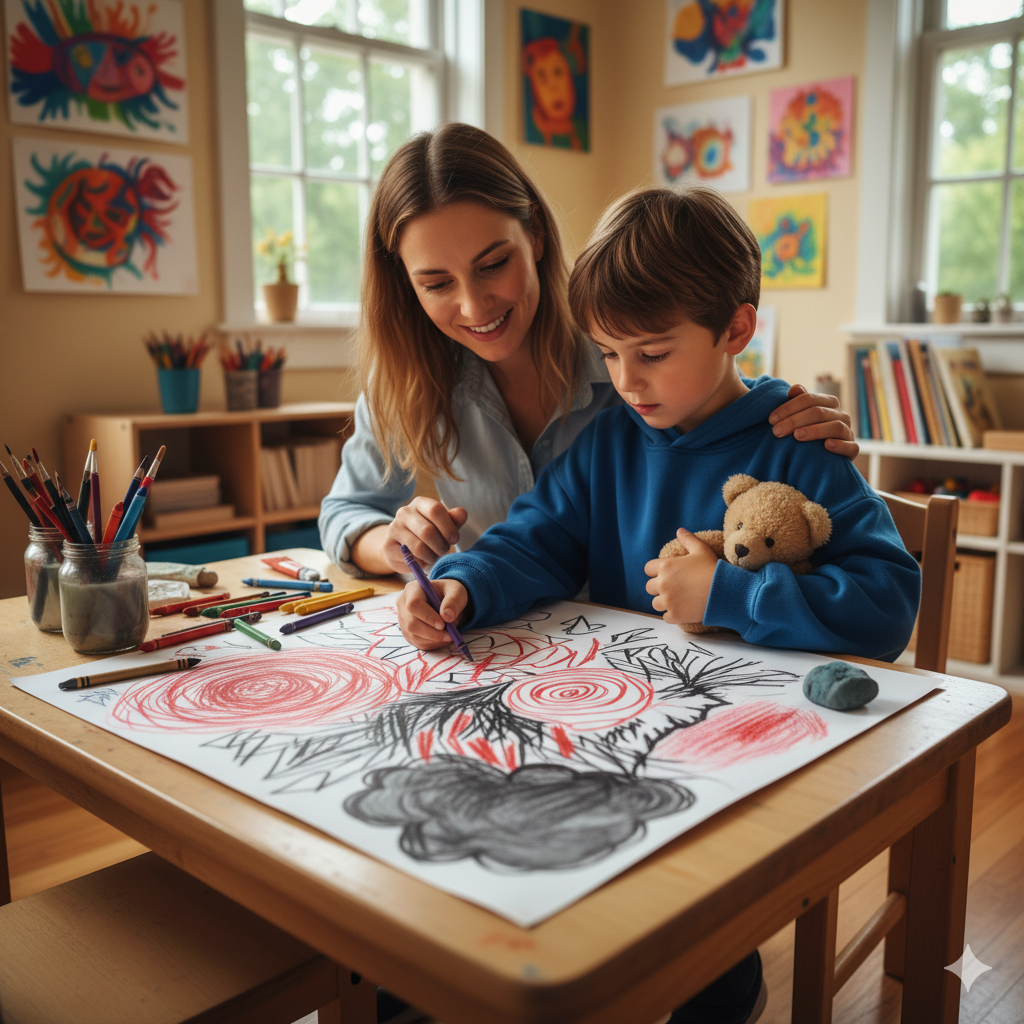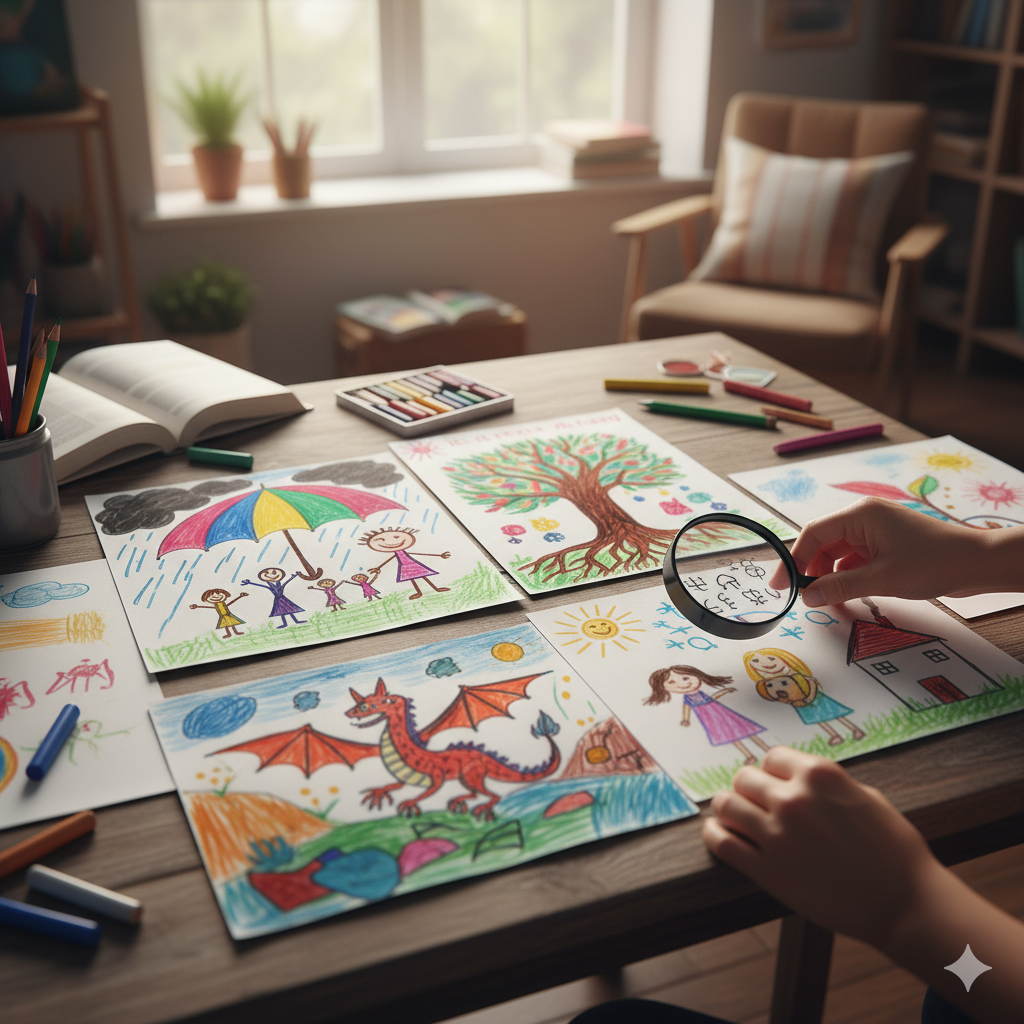The Science Behind Children's Artistic Expression
I was sitting with my five-year-old daughter as she concentrated intensely on drawing what she called "the most beautiful flower in the world." Her tongue was sticking out slightly, her brow was furrowed, and she was completely absorbed in her work. As I watched her, I couldn't help but wonder: what's actually happening inside that little head of hers right now? What kind of neurological magic is taking place as she transforms her vision into reality on paper?
The truth is, when children pick up a crayon and begin to draw, something absolutely remarkable happens in their brains. The simple act of creating art isn't just a fun activity—it's a complex neurological symphony that activates multiple brain regions, engages various cognitive processes, and triggers emotional responses that contribute to their overall development.
The Amazing Brain Orchestra
When All Regions Work Together
Imagine your child's brain as a conductor leading an orchestra, with each section playing a crucial role in the symphony of creativity. When my daughter draws, her frontal lobe is busy making executive decisions—choosing which colors to use, deciding what to draw first, and keeping her focused despite the distractions around her. It's like having a tiny CEO in her head, making strategic decisions about her artistic process.
Meanwhile, her parietal lobe is handling all the spatial processing. It's figuring out how to translate the three-dimensional flower she's imagining into a two-dimensional drawing on paper. It's coordinating the movement of her hand with what her eyes are seeing, creating that magical connection between vision and creation.
Her temporal lobe is like a vast library, storing memories of flowers she's seen before, recalling the names of colors, and connecting her current drawing with past experiences. And her occipital lobe is working overtime, processing all the visual information—the colors she's seeing, the shapes she's creating, the movement of her hand across the page.
The Magic of the Default Mode Network
What's particularly fascinating is that recent neuroscience research has revealed something incredible about artistic creation. When children are deeply engaged in art-making, their brain's "default mode network" lights up like a Christmas tree. This network is associated with self-reflection, creative thinking, and social cognition—basically, all the things that make us uniquely human.
It's like watching your child's brain go into a special "creative mode" where they're not just drawing—they're processing their experiences, generating new ideas, and developing a deeper understanding of themselves and their world.
The Default Mode Network
Recent neuroscience research has revealed that artistic creation activates the brain's "default mode network" (DMN), which is associated with:
- Self-reflection: Children thinking about their own experiences
- Creative thinking: Generating novel ideas and connections
- Social cognition: Understanding others' perspectives
- Memory consolidation: Processing and storing experiences
Cognitive Processes in Artistic Creation
Symbolic Thinking Development
Art creation is fundamentally about symbolic thinking—the ability to represent ideas, objects, or experiences through symbols:
Early Symbolic Thinking (Ages 2-4)
During early symbolic thinking, children begin to understand that a circle can become a face, a line can become a house, colors can represent emotions or objects, and simple shapes carry meaning.
Advanced Symbolic Thinking (Ages 5-8)
Advanced symbolic thinking involves complex symbols representing abstract concepts, metaphorical thinking through visual elements, personal symbols with individual meaning, and cultural symbols and their interpretations.
Working Memory and Art Creation
Creating art requires children to hold multiple pieces of information in their working memory, including visual information about what they want to draw, motor planning for how to make the marks, color choices for which colors to use where, spatial relationships for where to place elements, and narrative elements for the story they want to tell.
Executive Function Development
Art creation helps develop crucial executive functions:
Inhibitory Control
Inhibitory control develops through resisting the urge to scribble outside the lines, focusing on the task despite distractions, controlling impulsive movements, and following through with plans.
Cognitive Flexibility
Cognitive flexibility is strengthened by adapting when something doesn't work as planned, trying different approaches, switching between different elements, and problem-solving when faced with challenges.
Working Memory
Working memory is enhanced by remembering what they're trying to create, holding multiple elements in mind, planning sequences of actions, and monitoring progress toward goals.
The Emotional Neuroscience of Art
The Limbic System and Creative Expression
The limbic system, the brain's emotional center, plays a crucial role in artistic expression:
Amygdala (Emotional Processing)
The amygdala processes emotions that influence color choices, creates emotional associations with art materials, responds to the emotional content of their creations, and forms emotional memories connected to art experiences.
Hippocampus (Memory Formation)
The hippocampus stores art experiences as memories, retrieves past experiences to inform current creations, connects emotions with visual representations, and builds a personal artistic vocabulary.
Hypothalamus (Stress Response)
The hypothalamus regulates stress hormones during art creation, creates calming effects through repetitive motions, manages anxiety through creative expression, and promotes relaxation and well-being.
The Role of Neurotransmitters
Art creation affects various neurotransmitters that influence mood and cognition:
Dopamine
Dopamine is released during creative problem-solving, associated with pleasure and reward, motivates continued artistic engagement, and enhances learning and memory formation.
Serotonin
Serotonin is increased through repetitive, meditative art activities, associated with calm and well-being, helps regulate mood and emotional stability, and supports focused attention and concentration.
Endorphins
Endorphins are released during enjoyable art activities, provide natural pain relief and stress reduction, create positive associations with art-making, and enhance overall sense of well-being.
Motor Development and Art Creation
Fine Motor Skill Development
Creating art requires sophisticated fine motor control:
Grip Development
Grip development progresses from palmar grasp (12-18 months) where children hold crayons with their entire hand, to digital grasp (18-24 months) using fingers to hold tools, to tripod grasp (3-4 years) with thumb and two fingers holding a pencil, to dynamic tripod (5-6 years) with refined finger movements for precision.
Hand-Eye Coordination
- Visual tracking of drawing tools
- Coordinating hand movements with visual feedback
- Adjusting movements based on visual input
- Developing spatial awareness through movement
Bilateral Coordination
Art creation often requires both hands working together, including stabilizing paper with one hand while drawing with the other, using both hands for complex tasks like cutting and pasting, crossing midline when drawing large shapes or movements, and coordinated movements for activities like painting or sculpting.
Language Development Through Art
Visual-Spatial Language
Art creation helps children develop vocabulary for describing spatial relationships like "above," "below," "beside," and "inside," visual properties such as "bright," "dark," "rough," and "smooth," shapes and forms including "round," "square," "curved," and "straight," and colors and textures like "shiny," "matte," "transparent," and "opaque."
Narrative Language
Creating art supports storytelling abilities including sequencing by understanding beginning, middle, and end, character development through creating personalities for drawn figures, plot development by building stories around visual elements, and descriptive language using rich vocabulary to describe creations.
Emotional Language
Art provides a safe space for expressing emotions through emotional vocabulary by learning words for different feelings, emotional expression by showing feelings through visual means, emotional regulation through processing difficult emotions via art, and empathy development by understanding others' emotional expressions.
The Social Brain and Collaborative Art
Mirror Neurons and Imitation
Children learn artistic techniques through observation and imitation as mirror neurons fire when watching others create art, imitation helps children learn new techniques, social learning occurs through shared art experiences, and cultural transmission happens through artistic traditions and styles.
Theory of Mind Development
Creating art helps children understand others' perspectives through understanding intentions about why others create certain types of art, recognizing emotions by interpreting emotional content in artwork, cultural understanding by appreciating different artistic traditions, and social communication using art to communicate with others.
Individual Differences in Artistic Brain Development
Neurodiversity and Art
Children with different neurological profiles may approach art differently:
Children with ADHD
Children with ADHD may benefit from art's calming effects, often show creative problem-solving abilities, may prefer more dynamic, movement-based art activities, and can develop focus through engaging art projects.
Children with Autism Spectrum Disorders
Children with autism spectrum disorders may excel in detailed, precise artwork, often show unique perspectives and creativity, may benefit from art as a communication tool, and can develop social skills through collaborative art projects.
Children with Learning Differences
Children with learning differences may find art as an alternative form of expression, often show strengths in visual-spatial thinking, may benefit from art's multisensory nature, and can build confidence through artistic success.
Gender Differences in Brain Development
Research suggests some differences in how boys and girls approach art, including spatial processing that may develop differently, fine motor skills that may develop at different rates, color preferences that may be influenced by cultural factors, and artistic interests that may vary based on individual personality.
The Therapeutic Benefits of Art
Stress Reduction and Relaxation
Art creation activates the parasympathetic nervous system by reducing cortisol levels (the stress hormone), increasing relaxation through repetitive, meditative movements, promoting mindfulness by focusing on present-moment experience, and enhancing well-being through creative expression and accomplishment.
Emotional Processing
Art provides a safe way to process difficult emotions through externalization by putting internal feelings into external form, symbolic expression using symbols to represent complex emotions, catharsis by releasing pent-up emotions through creative expression, and integration by making sense of emotional experiences.
Cognitive Benefits
Art creation supports various cognitive functions including attention through sustained focus on creative tasks, memory enhanced through multisensory experiences, problem-solving through creative approaches to artistic challenges, and flexibility by adapting to unexpected outcomes.
Technology and the Artistic Brain
Digital Art and Brain Development
Digital art tools affect the brain differently than traditional materials, including screen time effects that impact attention and focus, touch feedback providing different sensory experiences, undo function reducing frustration and increasing experimentation, and infinite possibilities that may enhance creativity or overwhelm.
Balancing Digital and Traditional Art
Research suggests benefits of both approaches, with traditional materials being better for fine motor development, digital tools potentially enhancing certain cognitive skills, combined approach providing maximum benefit from both methods, and individual preferences where children may naturally prefer one or both.
Supporting Optimal Brain Development Through Art
Creating the Right Environment
Optimal brain development through art requires a low-stress environment that reduces cortisol and promotes creativity, rich sensory input through various textures, colors, and materials, appropriate challenge with tasks that are neither too easy nor too hard, and positive reinforcement by celebrating effort and creativity.
Providing Appropriate Materials
Different materials support different aspects of brain development, with large motor materials supporting gross motor development, fine motor materials enhancing precision and control, sensory materials stimulating multiple senses simultaneously, and open-ended materials encouraging creative problem-solving.
Encouraging Process Over Product
Focusing on the creative process rather than the final product reduces performance anxiety by allowing free exploration, encourages experimentation to promote creative thinking, builds intrinsic motivation where art becomes its own reward, and supports risk-taking by trying new techniques and approaches.
Conclusion
The science behind children's artistic expression reveals a complex interplay of neurological, cognitive, and emotional processes. When children create art, they're not just making pretty pictures—they're engaging in sophisticated brain development that supports learning, emotional regulation, and creative thinking.
Understanding this science helps us appreciate the importance of providing rich artistic experiences for children. Every drawing, painting, or sculpture represents not just a creative expression, but a complex neurological process that contributes to healthy brain development.
As parents and educators, we can support this development by providing appropriate materials, creating supportive environments, and celebrating the process of creation. By understanding the science behind artistic expression, we can better nurture the creative potential in every child.
The beauty of children's art lies not just in what we see on the page, but in the incredible neurological symphony that creates it. Each mark represents a connection between neurons, each color choice reflects emotional processing, and each creative decision demonstrates the remarkable complexity of the developing human brain.
Want to explore the scientific insights hidden in your child's artwork? Our AI-powered analysis tool can provide detailed information about the cognitive processes, developmental milestones, and creative expression patterns in your child's drawings. Try our child drawing analysis tool to discover the fascinating science behind your child's artistic creations.
---
The information in this article is based on current neuroscience research and should not replace professional evaluation. If you have concerns about your child's development, consult with a pediatrician or child development specialist.



